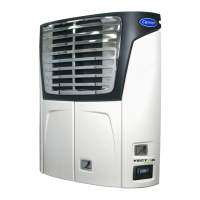62-11785 8–12
10. Purge nitrogen from system at the suction service valve.
11. Open the vacuum pump valve and start the pump. Evacuate unit to 500 microns. Close the vacuum pump valve
and shut off the pump. Wait a few minutes to be sure the vacuum holds below 2000 microns.
12. If vacuum holds below 2000 microns continue to step 14. If vacuum rises above 2000 microns continue to step
13.
13. Repeat steps 8 through 11 until the vacuum stays below 2000 microns.
14. Once the system holds a good vacuum, it is ready to be charged with refrigerant. Refer to
Section 8.5.2
.
b. Evacuation of the Low Side
1. Evacuate only after a low side leak check. (Refer to Section 8.5.3.)
2. If possible keep the temperature of the major components (condenser, evaporator, compressor and receiver)
above 60°F (15.6°C) to speed evaporation of moisture. If the temperature is lower than 60°F (15.6°C), ice might
form before moisture removal is complete. Heat lamps, heat guns or alternate sources of heat may be used to
raise system temperature.
3. The recommended method to evacuate the system is to connect three evacuation hoses with vacuum pump and
vacuum indicator (see
Figure 8.4
).
4. Ensure that the operator message panel displays “RECOVER/LEAK CHK/EVAC MODE” during the evacuation
and dehydration procedures. (Refer to
Section 5.2.5
.) If the control system switches to Charge Mode during the
process, switch it back to the “RECOVER/LEAK CHK/EVAC MODE”.
5. Leave the liquid line service valve and the discharge service valve frontseated and then midseat the suction
service valve.
6. Start the vacuum pump. Evacuate unit until the electronic vacuum gauge indicates 2000 microns. Close the
vacuum pump valve and shut off the pump. Wait a few minutes to be sure the vacuum holds.
7. Break the vacuum with dry nitrogen through the liquid line service valve. Raise system pressure to approximately
2 psig (0.1 bar). Ensure that the control system does not switch to the Charge Mode. If this occurs, switch it back
to the “RECOVER/LEAK CHK/EVAC MODE” (Refer to
Section 5.2.5
.)
8. Purge nitrogen from the low side of the system at the suction service valve.
9. Open the vacuum pump valve and start the pump. Evacuate unit to 500 microns. Close the vacuum pump valve
and shut off the pump. Wait a few minutes to be sure the vacuum holds below 2000 microns.
10. If vacuum holds below 2000 microns continue to step 12. If vacuum rises above 2000 microns continue to step
11.
11. Repeat steps 6 through 9 until the vacuum stays below 2000 microns.
12. Once the system holds a good vacuum, open the compressor discharge service valve and the liquid line service
valve.
13. Start unit and check the refrigerant charge. Refer to
Section 8.5.2
.
c. Evacuation of the Compressor
1. Evacuate only after a compressor leak check. Refer to Section 8.5.3.
2. Ensure the unit will not start automatically by disabling any two way communication and placing the START/
RUN-OFF switch in the OFF position. Disconnect the high voltage source and lockout/tagout the receptacle.
3. If possible keep the temperature of the compressor above 60°F (15.6°C) to speed evaporation of moisture. If the
temperature is lower than 60°F (15.6°C), ice might form before moisture removal is complete. Heat lamps, heat
guns or alternate sources of heat may be used to raise compressor temperature.
4. Connect evacuation equipment to the compressor suction and discharge service valves. See
Figure 8.4
.
5. Start the vacuum pump. Evacuate compressor to 500 microns. Close the vacuum pump valve and shut off the
pump. Wait a few minutes to be sure the vacuum holds. This checks for residual moisture and/or leaks.
6. Once the compressor holds a good vacuum, open the compressor suction and discharge service valve to allow
refrigerant to enter the compressor.
7. Start unit and check the refrigerant charge. Refer to
Section 8.5.2
.

